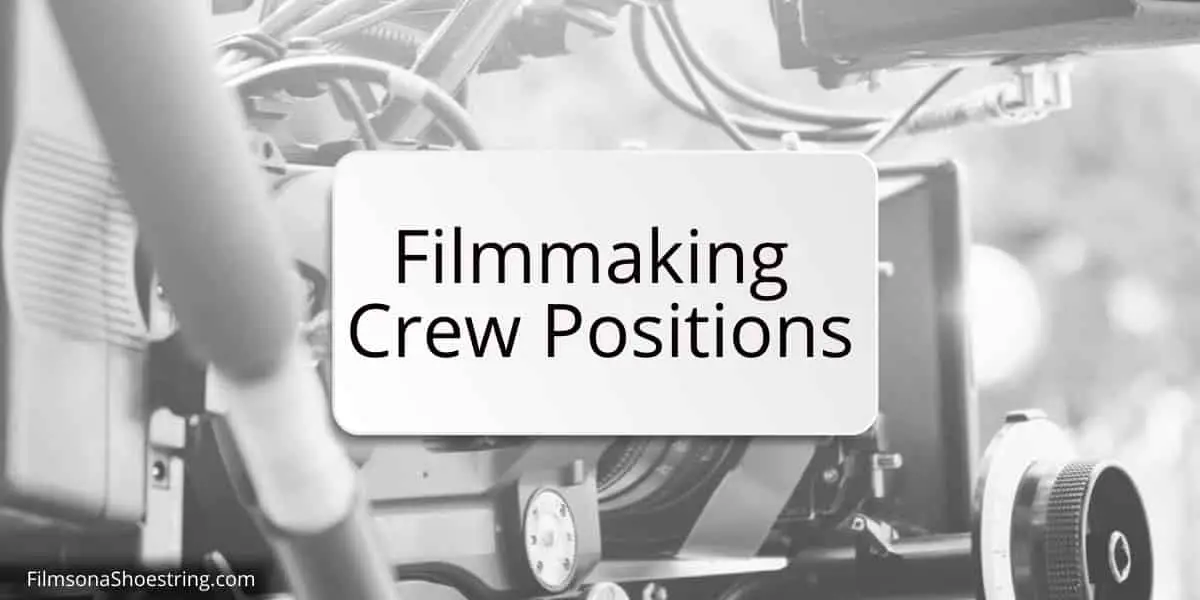Lighting department film roles are an essential part of any film crew, helping create the visual impact of each scene.
A professional film or TV production will rarely list a lighting department. Instead, they have electric and grip teams, often working as part of the Camera and Electrical Department, or similar.
But each team will have a set hierarchy of tasks and responsibilities, which will vary according to the production’s individual needs and circumstances.
Filmmakers working in film lighting and rigging work quickly, efficiently, and with safety at the forefront of everything they do.
Director of Photography
The Director of Photography, usually known as the DP or DoP, manages the camera department, lighting, electrical, and grips.
They work closely with the Director and department managers to translate the Director’s vision into reality on screen.
- More about the Director of Photography’s role
Electric Department
In a film production electrical department, also known as the electrical or lighting crew, there are several key roles responsible for managing and operating the lighting equipment on set to achieve the desired look and atmosphere for the film.
These roles can vary depending on the size and complexity of the production, but here are some common positions in the electrical department:
- Gaffer: The gaffer is the head of the electrical department and is responsible for designing and executing the lighting plan. They work closely with the director of photography (DP) to achieve the desired look and mood for each scene. The gaffer also manages the lighting crew and equipment.
- Best Boy Electric (First Assistant Chief Lighting Technician): The best boy electric is the gaffer’s right-hand person. They assist in managing the electrical department, including scheduling, budgeting, and equipment maintenance. They often handle paperwork and logistics, allowing the gaffer to focus on lighting design.
- Second Unit Gaffer: In larger productions, there may be a second unit gaffer who oversees lighting for specific sequences or shots that are filmed separately from the main unit.
- Lighting Technician (Electrician): Lighting technicians are responsible for setting up and operating lighting equipment, such as lights, stands, and power distribution. They follow the gaffer’s instructions to achieve the desired lighting effects.
- Rigging Gaffer: On larger productions, a rigging gaffer may be responsible for planning and executing the installation of lighting equipment in hard-to-reach or unconventional locations, such as rooftops or high rigs.
- Rigging Electrician: These electricians work under the rigging gaffer’s direction to install and secure lighting fixtures in challenging locations.
- Generator Operator: Generator operators are responsible for managing and operating the power generators that provide electricity for the lighting equipment on location shoots.
- Dimmer Board Operator: Dimmer board operators control the intensity of lights using a dimmer board or console. They work closely with the gaffer to achieve precise lighting adjustments during shooting.
- Lamp Operator: Lamp operators are responsible for maintaining and operating specialized lighting fixtures, such as HMI lights, xenon lights, or other types of advanced lighting equipment.
- Set Electrician: Set electricians are responsible for the electrical needs on set beyond lighting, such as powering monitors, cameras, and any other electronic equipment used during filming.
- Practical Electrician: Practical electricians are specialized electricians who focus on wiring and operating practical lights on set, such as lamps and fixtures that are part of the set design.
- Lighting Console Operator: In some productions, a lighting console operator may be responsible for programming and operating advanced lighting control systems, such as moving lights or LED fixtures.
These roles work together to ensure that the lighting on set meets the creative vision of the director and director of photography while maintaining safety and efficiency in the electrical department.
The specific titles and responsibilities may vary from one production to another, but these are the common positions you’ll find in the electrical department of a film production.
If you’re thinking about working in film lighting, there’s no need to rush to film school – start from the bottom and work your way up. Networking, exposure, and a positive attitude are key, along with strong practical skills.
- More about the Gaffer’s role in film production
- More about the Best Boy Electric
Grip Department
In a film production grip department, the crew is responsible for supporting the camera and lighting departments by providing essential equipment and rigging solutions. The roles within the grip department can vary depending on the size and complexity of the production, but here are some common positions you may find:
- Key Grip (Head Grip): The key grip is the head of the grip department and works closely with the director of photography (DP) and gaffer to achieve the desired camera and lighting setups. They oversee the grip team and are responsible for executing the grip plan.
- Best Boy Grip: The best boy grip assists the key grip in managing the grip department, including scheduling, equipment maintenance, and logistics. They may also handle paperwork and budgeting.
- Dolly Grip: Dolly grips operate camera dollies and other specialized camera movement equipment to achieve smooth and controlled camera movements. They work closely with the camera department to execute tracking shots.
- Crane Operator: Crane operators are responsible for operating camera cranes, which allow for dynamic and elevated camera movements. They work in coordination with the camera department to achieve specific shots.
- Rigging Key Grip: Rigging key grips specialize in installing and securing camera equipment and lighting fixtures in challenging or unconventional locations, such as on rooftops or high rigs.
- Grip: Grips are the general crew members who assist with various tasks, such as setting up and moving equipment, constructing camera rigs, and providing support for lighting setups. They often handle flags, nets, and other grip equipment to control light and shadows.
- Dolly Grip Assistant: Dolly grip assistants assist the dolly grip in setting up and operating camera dollies, ensuring that the equipment is in proper working order and that movements are executed safely.
- Rigging Grip: Rigging grips work under the rigging key grip’s direction to install and secure equipment, including camera rigs and lighting fixtures, in challenging locations.
- Stunt Grip: Stunt grips specialize in rigging equipment for stunt sequences, ensuring the safety and precision of stunts that involve complex rigging setups.
- Special Effects Grip: Special effects grips focus on creating and rigging practical special effects, such as rain, wind, explosions, or other physical effects that require precise timing and control.
- Cable Puller (Cable Hand): Cable pullers are responsible for managing and coiling cables used for electrical connections and equipment. They ensure that cables are organized and safely run on set.
- Grip Driver: Grip drivers are responsible for transporting grip equipment to and from the set, as well as helping with equipment setup and breakdown on location.
- Rigging Grip Driver: In cases where grip equipment needs to be transported to challenging locations, a rigging grip driver may be responsible for driving and operating vehicles used for transportation.
These roles work collaboratively to support the camera and lighting departments, ensuring that equipment is set up safely and efficiently to achieve the director’s vision. The specific titles and responsibilities may vary from one production to another, but these are some of the common positions you’ll find in the grip department of a film production.
- More about film crew roles
More for Filmmakers
- Low Budget Filmmaking: More for Less
- Lighting Department Film Roles
- Shooting An Interview
- Documentary Editing
- What is Sound Design in Film?
- Color Grading for Documentary Series or Film
- Film Set Etiquette: Professional Behaviour on Set
- Observational Documentaries And Their Impact
- Essential Skills for Film Industry Professionals
- How to Create a Storyboard in 6 Simple Steps
- What Makes a Film Successful
- Breaking into the Film Industry without Experience
- Sports Documentary Filmmaking
- How to Create a Storyboard Using Sticky Notes
- Remove Background Noise From Video
- Why Do Filmmakers Use Clapper Boards?
- Indie Films
- Indie Filmmaking
- What is Post Production in Film
- Ken Burns Effect: Creating Eye-Catching Sequences





















